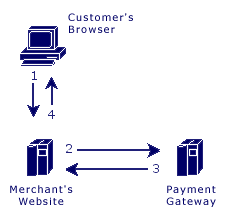Direct Post API
Methodology
Transaction Flow

Steps:
- The customer sends their payment information to the merchant's web site.
- The merchant web site posts the payment data to the Payment Gateway.
- The Payment Gateway responds immediately with the results of the transactions.
- The merchant web site displays the appropriate message to the customer.
The communication method used to send messages to the Payment Gateway's server is the standard HTTP protocol over an SSL connection.
In the Direct Post method, the communications with the cardholder (Steps 1 and 4) are developed completely by the merchant and therefore are not defined by the Payment Gateway. Step 1 should simply collect the payment data from the cardholder and Step 4 should display the appropriate transaction receipt or declined message.
In Step 2, transaction details should be delivered to the Payment Gateway using the POST method with the appropriate variables defined below posted along with the request.
In Step 3, the transaction responses are returned in the body of the HTTP response in a query string name/value format delimited by ampersands. For example: variable1=value1&variable2=value2&variable3=value3
Customer Vault
The Customer Vault was designed specifically for businesses of any size to address concerns about handling customer payment information. Visa and MasterCard have instituted the Payment Card Industry (PCI) Data Security to protect cardholder data, wherever it resides, ensuring that members, merchants, and service providers maintain the highest information security standards.
These associations have also deemed that merchants will be held liable for any breach of cardholder data. This has become a major concern for merchants who handle credit card or electronic check payments. The Customer Vault is designed for these merchants who desire to avoid the tremendous costs and resources involved in becoming PCI compliant under these circumstances.
The Customer Vault does this by allowing merchants to transmit their payment information through a Secure Sockets Layer (SSL) connection for storage in our Level 1 PCI certified data facility. Once the customer record has been securely transmitted to the Customer Vault, the merchant can then initiate transactions remotely without having to access cardholder information directly. This process is accomplished without the merchant storing the customer's payment information in their local database or payment application.
Apply for a Merchant Account
Signup for the Payment Gateway
Retail & Internet Merchant Accounts
An Internet Merchant Account is sometimes referred to as a "MOTO" (Mail Order & Telephone Order) Account because they all require the ability to process a credit card payment when there is no physical credit card present to be swiped. A standard retail "swipe" merchant account does not allow processing of these "card-not-present" transactions.
View details »
High Risk Merchant Accounts
If the domestic banks are denying your merchant application because they believe your industry is considered high risk, CyoGate can help! We have an offshore network of merchant processing partners that enable us to provide low cost, high risk merchant solutions to a much wider range of businesses and industries.
View details »
Internet Payment Gateway
The CyoGate Internet Payment Gateway offers one of the quickest and most cost effective ways to accept and process credit card and electronic check payments online. Our payment gateway works with most existing merchant accounts and supports hundreds of popular web shopping carts and eCommerce platforms.
View details »

